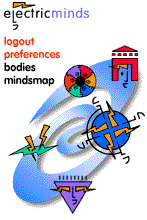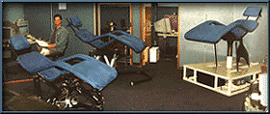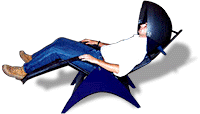
|

|
|
austin - jon lebkowsky
vr in 3space - realspace, mindspace, cyberspace
The
Flogiston Chair,
Brian Park's obsession of the last sixteen years, is familiar
from The
Lawnmower Man,
a cinematic fantasy that postulated cyberspace as a shamanic,
ultimately corrupting realm of power. However bogus the film might have been, it was seen by many, and so serves to provide Brian a point of departure
in explaining the story behind this ultimate piece of cyberfurniture.
If you saw the film, you'll recall a high-tech chair that held the body in a
neutral, suspended posture while the user was immersed in a virtual reality experience. Brian compares the relaxing antigravity sensation of sitting in one of his chairs to that achieved in the supine savasana yoga posture.
"Flogiston" is a hash of the words
"flow" and "phlogiston," an eighteenth-
century term for a theoretical essential substance released when
matter was burned. Says Brian, "The theory dates to the
transitional period between alchemy and chemistry."
In the years he has spent working on his chairs, Brian has sought "the integration of
cyberspace with mindspace and realspace -- the three components
of what he calls "3Space."
He has been working with NASA in developing uses for the chair as a physical base for VR simulations. The current Flogiston has a motorized base for movement simulation, plus
way-high-fidelity stereo speakers and a domed rear-projection
screen (replacing head-mounted display) for audiovisual jams.
Why the dome? Tests at Johnson Space Center convinced
Brian that head mounted displays didn't work on a moving motion
base. Neck strain and inertia effects were distracting and disruptive
to the simulation. Astronauts who could train for space walks
for six to eight hours in water could only go half an hour at
a time with HMD-based VR before complaining about neck problems
and disorientation. Brian was convinced that a more immersive
VR environment could be created, where training could go on for
hours at a time without fatigue or discomfort.
His search for an alternative to the head mounted
display actually began with the problem of movement. Astronauts navigate, manipulate objects, etc., but much of the time they're tethered and crawling around in the cargo bay. The experience is tactile, so Brian and his colleagues added motion cueing and collision detection: if the astronaut virtually "bumped" something, they'd be joggled. This led to a conception of the chair as a generic immersive system with vision, sound,
vibration, and a motion cue. Subtle, smooth motion is necessary
to make motion cueing truly effective, especially when you're
simulating a sensation of floating.
So Brian researched motion bases, beginning with a low-end air-powered Vertigo. When the motion base was added to the chair, the HMD didn't work well enough. He considered placing the chair inside a "cave" or big tented cube, but this would run $1 million plus the cost of a high-powered
reality engine. There had to be a lower-cost alternative.
 The wraparound image was there, though distorted and too close. Brian ultimately designed a 12" dome for the immersion screen. Though projector resolution is too low today, they're evolving quickly. The current standard is XGA, 800 by 600 pixels. And Pioneer's newly announced XG1 is 1024x768 -- that's ideal. "Basically we're trying to reproduce the field of view that the eye sees, which is roughly 180 by 120 degrees," Brian says. "The intent is for the area of focus directly in front of your eyes to be sharp. With peripheral vision you're more focused on changes, dynamic movement. You're focusing on a small area, so the quality at the periphery doesn't have to be sharp to simulate true vision." Brian's come a long way with the chair. He started in 1980, originally designing the chair as a place for meditation and rest. Later, as a CAD manager running a design group for an oilfield company, he first used the chair with computers, suspending the CRT in front and putting the keyboard in the user's lap. He started working with VR people in '91, beginning with Eric Gullichsen at the First Conference on Cyberspace. Through contact with NASA, Brian learned of the neutral posture, a standard for space station development. Says Brian, "In the first eight weeks of life, before we become a fetus, while we're still an embryo, while we're still and not moving, we form our bodies in this neutral posture," he says. "We float in the void, coming out of nothing into something, in this posture. After eight weeks, we start moving, getting larger, getting squashed inside the womb. But those relative positions of the limbs are with us all our lives. When we take away external forces, we return to this neutral posture" The chair is designed to reduce awareness of physical stimuli. "We've got fifteen senses in our body, not just five senses. The chair minimizes our awareness of those senses. Then we accentuate virtual stimuli for a greater sense of immersion in cyberspace. The 3space idea is that while we can live in three spaces, we're essentially bipolar animals -- that's all we've known. What I'm doing here is creating an alternative bipolar situation by getting rid of the realspace vector, and leaving the mindspace/cyberspace vector." "At first I thought I was creating a true 3space environment, but I'm not. I'm really just creating a different 2space environment. You're still getting the bipolar flow, but it's coming from cyberspace, rather than real space." |
jzitt said: One thing I liked about living in (of all places) Brooklyn, was that I could walk to anything I needed to get to. For that matter, I've lived over the years in two places in Austin where I didn't need a car except for getting to work: Riverside Drive a few blocks from I-35 (back when Half-Price Books was still there) and at the Northcross Apartments, across from the Northcross Mall and the Village Theatre. The Northcross location was quite nice -- I was off a walkway far enough, but not too far, from the parking lot. I ate at Furr's at the mall a lot -- It was actually closer to my apartment than the college dining hall was when I was a student, and the food was of comparable quality, so I sort of considered it the commune eatery. :-) Most Active Topics: Topic 4 Slacker: Austin or Anytown? Topic 62 Conference Biz: Feedback and Discussion Topic 113 Country and Eastern Music | |||
 What I'm doing here is creating an alternative bipolar situation by getting rid of the realspace vector, and leaving the mindspace/cyberspace vector.  | ||||
Also in Austin: On a Rock and Roll Fire Truck vr in 3space - realspace, mindspace, cyberspace going native in cyberspace | ||||
|
|
|
electric minds |
virtual community center |
world wide jam |
edge tech |
tomorrow |
conversations
Any questions? We have answers.
©1996, 1997 electric minds, all rights reserved worldwide.
|
